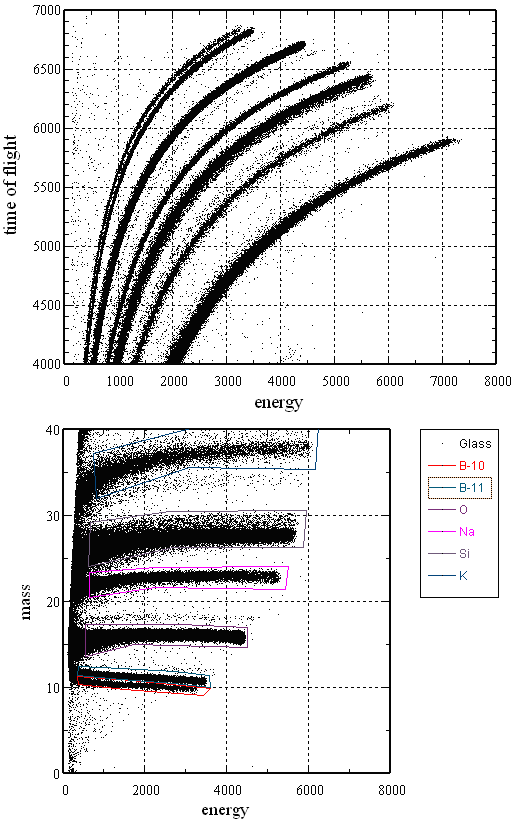
developed by François Schiettekatte
with the active participation of Subhash Gujrathi and Martin Chicoine
dernière mise à jour
2004/05/13
Allegria is a software package for ion beam analysis that has been developed to replace the previous VAX-based ERD program
running at the Université de Montréal until 1999 to manage
and analyse the data from our ERD-TOF setup. As we now also host a gas-counter
ERD setup, Allegria has been designed with the objective of being
versatile enough to analyse ERD data acquired with several types of multi-parameter
detection techniques. The package can be viewed as a merger between Alegria 1.2, reusing its graphical routines, and the ERD program developed initially for the first ERDA setup and improved over the years for ERD-TOF analysis. A first application, SpectrumExtractor,
provides a graphical interface to extract mass separated energy spectra form
an event-list file. Several kinds of data projections can be performed, including
energy, time, mass and decay. A second application, Allegria, is mostly
an interface to input the experimental parameters that are passed to the
"conversion engine" of the ERD program and to show the resulting depth profiles.
The ERD program iteratively performs the energy-spectrum to depth-profile
conversion. It includes energy calibration calculations involving Pulse Height
Defects corrections for each element, can process a number of different ERD
or Rutherford Backscattering Spectrometry (RBS) spectra in a single run and
now incorporates stopping power calculations based on SRIM-2000 parameters.
Developed with Trolltech Qt, the software works under various platforms such as Windows and Linux, and is freely available with its source code under GNU licensing conditions. We have been using it for more than a year so it should now be usable by the community.
For further description, please refer to the following paper:
- F. Schiettekatte, M. Chicoine, S. Gujrathi, P. Wei, K. Oxorn, Allegria: a new interface to the ERD program, Nucl. Inst. Meth. B 219–220 (2004) 125
Release 040513 (first public release)
- Instructions
- Manual (pdf, 118 Kb)
- The 5 minutes guide to Allegria (88 Kb PDF): an ERD-TOF example that quickly takes you around Allegria (suggested for first time users)
- Handling a spectrum (114 Kb PDF): through the analysis of an RBS spectrum, shows how to subtract a background, extract a peak from a spectrum, etc.
- Windows:
- example/tutorial files (include programs, parameter files and data):
- TOFexample.zip (4.7 Mb)
- RBSexample.zip (2.0 Mb)
- gas-counter ERD: coming soon
- executables (version 040513, 313 Kb, useful only for updates, no parameter files included, donwload examples above if parameter files are required. Compiled with the Qt Windows non-commercial library)
- sources (version 040513, 172 Kb, Microsoft Visual C project, Qt licence required to compile)
- Linux:
- sources and instructions to install (137 Kb)
- example files (data and parameter files only):
- TOFexample.gz
- RBSexample.gz
- gas-counter ERD: coming soon
To report bugs/problems, please send a detailed e-mail to François Schiettekatte describing the problem , how it occurred, etc. If the related data file is not too big (<3 Mb), you may attach it to your message as well.
Example of a Glass analysed by ERD-TOF
